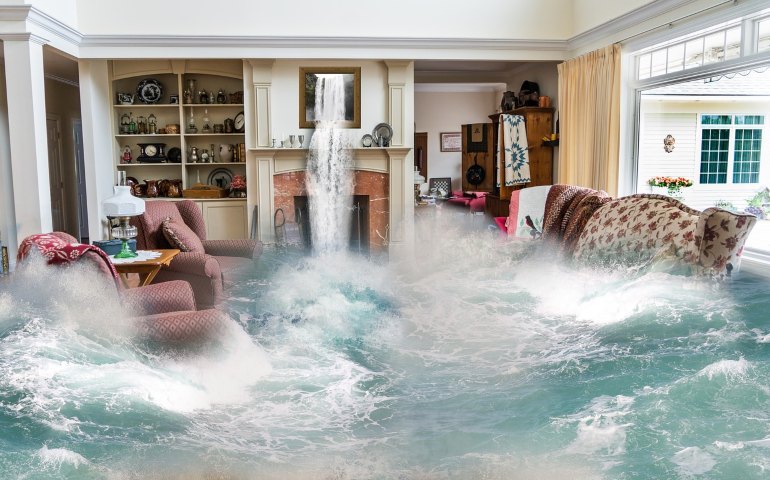How to spot signs of escape of water
Water escape can wreak havoc, leading to costly damages and inconveniences. Whether it’s a burst pipe, a leaky washing machine, or a faulty central heating system, escape of water damage can be severe. As a tenant or landlord, knowing how to spot the signs of water escape is crucial in preventing extensive damage and handling insurance water claims efficiently.
In this blog, we explore common causes of escape of water, practical steps to reduce the risk of escape of water incidents and the importance of insurance coverage.
Common Causes of Water Escape
Understanding the common causes of water escape is the first step in mitigating the risk of damage to your property. Here are some typical culprits to watch out for:
- Burst Pipes: Freezing temperatures or wear and tear on ageing pipes can cause them to burst, releasing a significant amount of water into your property.
- Leaky Appliances: Washing machines, dishwashers and refrigerators with ice makers are common sources of water leaks.
- Central Heating System Issues: Faulty boilers or radiators can lead to water escape, causing extensive damage if not promptly addressed.
- Leaking Roof: Damaged or improperly sealed roofs can allow water to seep into your home, leading to water damage in ceilings and walls.
Spotting Signs of Water Escape
Escape of water is a common issue, so we recommend regularly inspecting appliances, roofs, heating systems and pipes for any signs of leaks or malfunctions. Early detection of water escape is key to preventing significant damage to your property. Here are some common signs to look out for:
- Visible Water Leaks: Obvious signs of water leaks, such as water dripping from ceilings or pooling on the floor, require immediate attention.
- Damp or Musty Odours: Unpleasant smells, particularly in closed spaces or near walls, may indicate hidden water leaks or seepage.
- Water Stains: Yellowish-brown stains on walls or ceilings are telltale signs of previous or ongoing water escape.
- Mould and Mildew: The presence of mould or mildew in bathrooms, kitchens, or basements often indicates excess moisture and possible water escape.
- Unexplained Increase in Water Bills: If you notice a sudden spike in your water bill without a reasonable explanation, there might be an undetected water leak.
Preventing Water Escape
While you can’t always prevent escape of water from happening, you can take proactive steps to reduce the risk of water escape and minimise potential damages:
- Regular Maintenance: Schedule regular inspections and maintenance for plumbing systems, appliances, and central heating systems. Address any issues promptly.
- Install Leak Detection Devices: Consider installing leak detection devices that can alert you to potential leaks or bursts, allowing you to take immediate action.
- Insulate Pipes: Insulate pipes to protect them from freezing and bursting.
- Monitor Water Pressure: High water pressure can stress pipes and increase the risk of leaks. Use a pressure regulator to maintain optimal levels.
- Know the Location of Shut-off Valves: Familiarise yourself with the location of shut-off valves for the water supply in your property. In case of an emergency, quickly cut off the water source to prevent further damage.
Reporting and fixing water escape
Tenant’s Responsibilities
It’s important to note that a tenant has certain responsibilities when it comes to reporting and addressing water leaks in a rental property:
- Prompt Reporting: Tenants should promptly report any signs of water leaks to the landlord or property management to allow for immediate action.
- Taking Preventive Measures: Tenants should take reasonable precautions to prevent water leaks, such as avoiding actions that could damage plumbing fixtures or causing water damage through negligence.
Landlord’s Responsibilities
Landlords in the UK have specific legal obligations regarding repairs and maintenance, including addressing water leaks. The landlord’s responsibilities include:
- Timely Repairs: Landlords must respond promptly to reports of water leaks and undertake necessary repairs to mitigate the damage and restore the property.
- Ensuring Habitable Conditions: The landlord must ensure that the rental property remains habitable and safe for the tenant’s use. This includes addressing water leaks that could compromise the property’s habitability.
Importance of Insurance Coverage
One of the essential aspects of protecting your property from water escape is having adequate buildings or contents insurance coverage. Most landlord insurance policies cover escape of water incidents, but it’s crucial to review your policy to understand the specific terms and conditions. There are two primary types of coverage related to water escape:
- Landlords’ Buildings Insurance: This type of insurance covers the physical structure of your property, including walls, roofs, floors, and permanent fixtures. If a burst pipe causes damage to your walls or ceilings, buildings insurance may cover the repair costs.
- Landlords’ Contents Insurance: Contents insurance protects your belongings inside the property, such as furniture, electronics, and personal items. If a faulty washing machine damages your belongings, contents insurance may help with the replacement costs.
As a tenant in the UK, you can protect yourself against water escape incidents by obtaining the appropriate insurance coverage. Here are two types of insurance that tenants can consider safeguarding their belongings and liability in case of water escape:
- Contents Insurance, also known as tenant’s insurance or renter’s insurance, is designed to protect the tenant’s belongings and personal possessions against various risks, including water escape. This type of insurance covers the cost of replacing or repairing damaged or lost items due to covered events, such as burst pipes, leaks, and flooding.
- Tenant’s liability insurance, also known as personal liability insurance or renter’s liability insurance, covers the tenant in case they accidentally cause damage to the rental property. This can be particularly useful in situations where the tenant’s actions lead to water escape incidents, such as accidentally causing a pipe to burst.
Tenant’s liability insurance can help cover the cost of repairs to the rental property caused by the tenant’s negligence, up to the policy’s specified limit. It can also provide coverage for legal expenses if the landlord sues the tenant for the damage.
Conclusion
Water escape is a common and potentially damaging issue that homeowners and property managers must be vigilant about. By knowing how to spot the signs of water escape, understanding the importance of insurance coverage, and implementing preventive measures, you can protect your property from extensive damage and handle potential insurance claims more effectively. Regular maintenance, quick action, and the right insurance coverage are key elements in safeguarding your property against water-related incidents.
Book your 30-minute complimentary property consultation by phone: 020 8994 7327 or email: pm@bluecrystallondon.co.uk.


